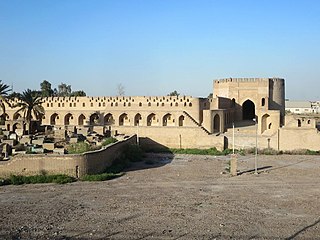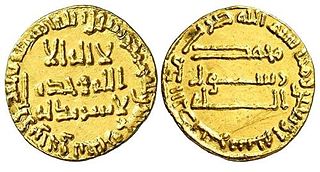 W
WThe Abbasid civil war of 865–866, sometimes known as the Fifth Fitna, was an armed conflict during the "Anarchy at Samarra" between the rival caliphs al-Musta'in and al-Mu'tazz, fought to determine who would gain control over the Abbasid Caliphate. The war, which lasted for about a year, largely revolved around a prolonged siege of Baghdad and ended with al-Mu'tazz as sole caliph. Al-Musta'in was abandoned by his supporters and forced to abdicate; in spite of a guarantee that his life would be spared, he was executed shortly afterward.
 W
WThe Abu Hanifa Mosque also known as is one of the most prominent Sunni mosques in Baghdad, Iraq.
 W
WThe Al-'Adudi Hospital was established during the era of organized hospitals developed in medieval Islamic culture. Some of these early hospitals were located in Baghdad and among those was the bimaristan Al-'Adudi. The hospital came to be when King of the Buyid Dynasty, 'Adud al-Dawla, decided to construct the hospital a few years before he died. Al-'Adudi was considered one of the most innovative and modern hospitals of the medieval Islamic time period. Amongst well-known physicians of the time period, this hospital was known as an institution for learning and practicing medicine.
 W
WThe Baghdad Manifesto was a polemical tract issued in 1011 on behalf of the Abbasid caliph al-Qadir against the rival Isma'ili Fatimid Caliphate.
 W
WThe Battle of Baghdad was fought between the forces of the Buyid Emirate of Iraq under Mu'izz al-Dawla and the Hamdanid Emirate of Mosul under Nasir al-Dawla within the city of Baghdad. The battle lasted for several months; it eventually ended in victory for the Buyids, who expelled the Hamdanids from Baghdad with a major offensive and secured control of the city.
 W
WThe gates of Baghdad refers to the several bab, meaning gate in Arabic, connected by walls surrounding the city of Baghdad. The gates and the walls were designed to protect the city from the foreign invasions. Some of the components date back to the Abbasid era, while others were preserved and renovated during the Ottoman era.
 W
WThe Great Mosque of al-Mansur was the chief Friday mosque of Baghdad during the Abbasid Caliphate.
 W
WThe House of Wisdom, also known as the Grand Library of Baghdad, refers to either a major Abbasid public academy and intellectual center in Baghdad or to a large private library belonging to the Abbasid Caliphs during the Islamic Golden Age. The House of Wisdom is the subject of an active dispute over its functions and existence as a formal academy, an issue complicated by a lack of physical evidence following the collapse of the Abbasid Caliphate and a reliance on corroboration of literary sources to construct a narrative. The House of Wisdom was founded either as a library for the collections of the Caliph Harun al-Rashid in the late 8th century or was a private collection created by Al-Mansur to house rare books and collections of poetry in both Arabic and Persian.
 W
WAl-Mansur or Abu Ja'far Abdallah ibn Muhammad al-Mansur was the second Abbasid Caliph reigning from 136 AH to 158 AH and succeeding his brother Abu al-'Abbas al-Saffah. Al-Mansur is generally regarded as the real founder of the Abbasid Caliphate, one of the largest polities in world history, for his role in stabilizing and institutionalizing the dynasty. He is also known for founding the 'round city' of Madinat al-Salam which was to become the core of imperial Baghdad.
 W
WMeadows of Gold and Mines of Gems is an historical account in Arabic of the beginning of the world starting with Adam and Eve up to and through the late Abbasid Caliphate by medieval Baghdadi historian Al-Masudi.
 W
WAbu'l-Abbas Ahmad ibn Talha al-Muwaffaq, better known by his regnal name al-Mu'tadid bi-llah, was the Caliph of the Abbasid Caliphate from 892 until his death in 902.
 W
WMustansiriya Madrasah was a medieval-era scholarly complex that provided a universal system of higher education. It was established in 1227 CE and was named after and built by the Abbasid Caliph al-Mustansir in Baghdad, Iraq. The Madrasa taught many different subjects, including medicine, math, literature, grammar, philosophy, and Islamic religious studies. However, the major focus of education was Islamic law. It became the most prominent and high-ranking center for Islamic studies in all of Baghdad. Madrasas during the Abbasid period were used as the predominant instrument to foster the spread of Sunni thought as well as a way to extend the founder's pious ideals. The architecture of the Madrasa was also an important example of Islamic architectural development in Baghdad. The Madrasa has experienced several periods of decline and reemergence throughout its history. The most significant degradation to the Madrasa's architecture and position within Baghdad was the Mongol Siege of Baghdad (1258). Today, the Madrasa is in a state of restoration as is it being overseen by the Directorate of Antiquities in Iraq. It is currently a part of the Al-Mustansiriya University, and is located on the left bank of the Tigris River. Adjacent landmarks include the Saray souq, the Baghdadi Museum, Mutanabbi Street, the Abbasid Palace, and Caliph's Street.
 W
WThe Round City of Baghdad is the original core of Baghdad, built by the Abbasid Caliph al-Mansur in 762–766 CE as the official residence of the Abbasid court. Its official name in Abbasid times was The City of Peace. The famous library known as the House of Wisdom was located within its grounds.
 W
WThe siege of Baghdad was a part of a civil war between al-Amin and al-Ma'mun for the Abbasid Caliphate of Baghdad. The siege lasted from August 812 until September 813. The siege is described in great detail by Muhammad ibn Jarir al-Tabari in his famous History of the Prophets and Kings.
 W
WThe Siege of Baghdad in 1157 was the last Seljuq attempt to capture Baghdad from the Abbasids. Caliph al-Muqtafi successfully defended his capital against the coalition armies of Seljuq Sultan Muhammad of Hamadan and Qutb ad-Din of Mosul.
 W
WThe Siege of Baghdad was a siege that took place in Baghdad in 1258, lasting for 13 days from January 29, 1258 until February 10, 1258. The siege, laid by Ilkhanate Mongol forces and allied troops, involved the investment, capture, and sack of Baghdad, which was the capital of the Abbasid Caliphate at that time. The Mongols were under the command of Hulagu Khan, brother of the khagan Möngke Khan, who had intended to further extend his rule into Mesopotamia but not to directly overthrow the Caliphate. Möngke, however, had instructed Hulagu to attack Baghdad if the Caliph Al-Musta'sim refused Mongol demands for his continued submission to the khagan and the payment of tribute in the form of military support for Mongol forces in Persia.